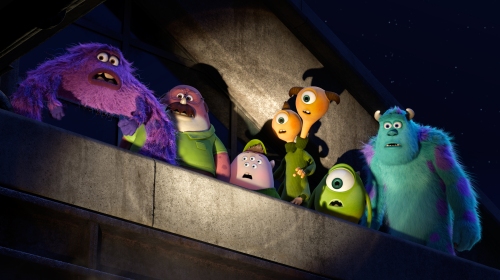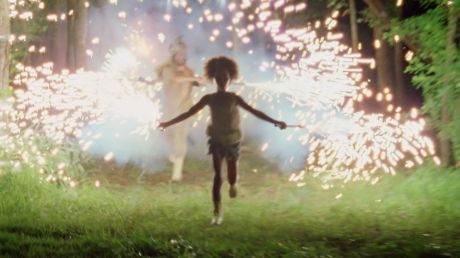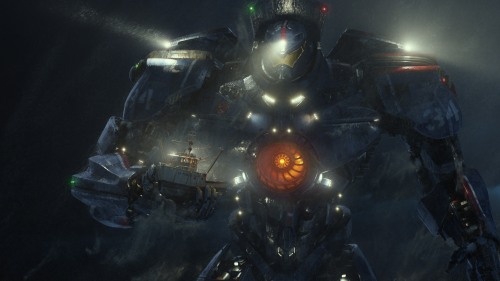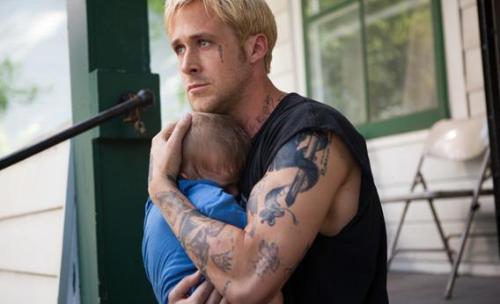Where The Wild Things Were

The gang were shocked when they heard what they had to do for the rugby initiation.
JJ SAYS:
Monsters University is the latest offering from Pixar and, as the title suggests, focuses on the exploits of Monsters Inc. protagonists Mike and Sully (albeit at a much younger age) as they attempt to graduate ‘scare school’, a seemingly pivotal stepping-stone to becoming professional Scarers. At its core the film is essentially a coming of age story as the two battle against the odds to retain their places at MU, becoming best friends in the process. It’s a largely enjoyable film and certainly succeeds as a piece of summer box office material, but it fails to elevate itself into the higher echelons of the Pixar canon.
Monsters University has a lot going for it, and certainly manages to recapture aspects of what made its predecessor so successful. Billy Crystal (Mike) and John Goodman (Sully) both comfortably reprise their roles after more than a decade long hiatus, bringing the same liveliness and warmth to their characters, as well as recreating the genuine chemistry the pair shared in Monsters Inc. Moreover the animation looks incredible, with the university campus moving through the seasons as the story progresses; autumn looks particularly photorealistic.
The movie is also, at times, genuinely funny; and even when the jokes are slightly off key there is a pervasive light-heartedness and sense of fun which is difficult to fault. The college fraternities are perhaps the most evident example of this, and although Roar-Omega-Roar is not the most scintillating idea Pixar has ever had, the much looked down upon Oozma Kappa provide a significant amount of the films amusement. While director Dan Scanlon may only have a short list of credits to his name the direction is, on the whole, capable. An early scene in which Mike moves into his university dorm is handled with particular finesse.
Having said that, the film does, occasionally, drift into patent blandness, specifically during a Rocky-esque montage scene that, even without the Bill Conti theme, feels as though it’s been used a thousand times before and was, fundamentally, a lazy way to progress the story.
Perhaps the biggest issue with Monsters University is the plots lack of direction, which sometimes feels aimless. While the movie is certainly charming, it doesn’t seek to stretch itself in any way; the story, the script and even the jokes are all fairly conservative. Fundamentally, it never tries to be anything other than good and it’s largely for this reason that the film falls drastically short of the Pixar classics. While the studio’s usual hallmarks are present, Monsters University fails to break any new ground and numerous scenes feel overly familiar and stale. Obviously, a certain amount of this familiarity comes from the fact Monsters University is a prequel and therefore was always going to be a recognisable movie. However, this fails to explain the fact that intermittently the movie feels as though it’s going out of its way to ‘tick boxes’.
Considering the strength of past Pixar work, which almost always seemed to be stretching the medium, it seems a shame that the studio’s latest effort is, for all its upside, a long way from the pantheon of Pixar greats.
====VERDICT====
Monsters University is, in its own right, an enjoyable and entertaining movie; to some degree its flaws are only noticeable because of the peerless work Pixar has produced in years past.
2.5/4
CJ SAYS:
Sex, vast quantities of spirits, slackers, student houses with sub-standard hygiene, etc. The components of university life have become the bedrock of an entire film genre. All the big studios have tackled the college comedy. Universal with National Lampoon’s Animal House. Touchstone had The Waterboy. MGM, Legally Blonde. A combination of slapstick and an extensive vocabulary relating to the female genatalia is as entertaining for audiences as a night out at the Union Pub.
Pixar, it’s fair to say, aren’t the most likely studio to have a pass at the genre. It is also fair to say that Pixar is no ordinary studio. Despite the potential hot water, Monsters University takes on the genre and does so with honours.
The newest edition to the Pixar universe marks the return of Mike (voiced by Billy Crystal) and Sulley (voiced by John Goodman) to Monstropolis – the world behind our closet doors. Monsters University takes us back to Mike and Sulley’s student days, where our furry/slimy protagonists met as college freshmen. Both enrolled on the scare programme, the pair clash from the start, Mike’s tennis ball head constantly in a textbook, while Sulley rests on the laurels of his family name. A run-in with Dean Hardscrabble – a half-dragon, half-centipede hybrid voiced by an icy Helen Mirren – leads to both pupils getting kicked off the programme. In a bid to win back their place the drop-outs enter the Scare Games, albeit with the Oozma Kappa fraternity (the equivalent of the Sci-Fi Club you avoid signing up for at the Society Fair).
While there are plenty of homages to its predecessor (the customary John Ratzenberger cameo is warmly received), Monsters University succeeds as a stand-alone story about the trials and tribulations of life during and post-college. Unable to employ staple college comedy gags, Pixar instead lampoons many of the characteristic features of student life. A (non-alcoholic) version of beer pong in the Roar-Omega-Roar frat house to a prank involving a pig-cum-Angry Bird mascot demonstrates the studio’s boundless creativity while also working as a witty depiction of the folly that goes on around campus.
Yet, besides all the fuzzy freshers antics, there is something more subdued about Monsters University compared to its Pixar counterparts. A younger Mike and Sulley are, ironically, more philosophical and less dysfunctional than their Monsters, Inc., selves. The studio also does a complete U-turn on its previously “can do” ethos highlighting arguably the toughest lesson of all: no matter how hard you work, you don’t always get what you want. A profound lesson and one that Pixar admirably imparts. However, it leaves very little by way of comic material which is made apparent throughout the film’s duration.
Since Toy Story 3, Pixar has struggled to strike the balance between humour and heart. Cars 2 was lacklustre and predictable (much like Formula 1) and Brave lacked any iota of wit (much like the Scottish). Though signs of the high-energy tempo of Monsters, Inc., are there, Monsters University is far more mature than its predecessor. There is less fun and more of a focus on message and meaning. More didactic, less quirk. It is still very entertaining, but closer to the demeanour of a professor rather than a student.
====VERDICT====
Like a post-grad student, mature but often a good laugh.
3/4





